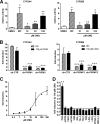Carboxymefloquine, the major metabolite of the antimalarial drug mefloquine, induces drug-metabolizing enzyme and transporter expression by activation of pregnane X receptor
- PMID: 25313206
- PMCID: PMC4291335
- DOI: 10.1128/AAC.04140-14
Carboxymefloquine, the major metabolite of the antimalarial drug mefloquine, induces drug-metabolizing enzyme and transporter expression by activation of pregnane X receptor
Abstract
Malaria patients are frequently coinfected with HIV and mycobacteria causing tuberculosis, which increases the use of coadministered drugs and thereby enhances the risk of pharmacokinetic drug-drug interactions. Activation of the pregnane X receptor (PXR) by xenobiotics, which include many drugs, induces drug metabolism and transport, thereby resulting in possible attenuation or loss of the therapeutic responses to the drugs being coadministered. While several artemisinin-type antimalarial drugs have been shown to activate PXR, data on nonartemisinin-type antimalarials are still missing. Therefore, this study aimed to elucidate the potential of nonartemisinin antimalarial drugs and drug metabolites to activate PXR. We screened 16 clinically used antimalarial drugs and six major drug metabolites for binding to PXR using the two-hybrid PXR ligand binding domain assembly assay; this identified carboxymefloquine, the major and pharmacologically inactive metabolite of the antimalarial drug mefloquine, as a potential PXR ligand. Two-hybrid PXR-coactivator and -corepressor interaction assays and PXR-dependent promoter reporter gene assays confirmed carboxymefloquine to be a novel PXR agonist which specifically activated the human receptor. In the PXR-expressing intestinal LS174T cells and in primary human hepatocytes, carboxymefloquine induced the expression of drug-metabolizing enzymes and transporters on the mRNA and protein levels. The crucial role of PXR for the carboxymefloquine-dependent induction of gene expression was confirmed by small interfering RNA (siRNA)-mediated knockdown of the receptor. Thus, the clinical use of mefloquine may result in pharmacokinetic drug-drug interactions by means of its metabolite carboxymefloquine. Whether these in vitro findings are of in vivo relevance has to be addressed in future clinical drug-drug interaction studies.
Copyright © 2015, American Society for Microbiology. All Rights Reserved.
Figures







Similar articles
-
Antimalarial artemisinin drugs induce cytochrome P450 and MDR1 expression by activation of xenosensors pregnane X receptor and constitutive androstane receptor.Mol Pharmacol. 2005 Jun;67(6):1954-65. doi: 10.1124/mol.104.009019. Epub 2005 Mar 10. Mol Pharmacol. 2005. PMID: 15761118
-
Effects of atorvastatin metabolites on induction of drug-metabolizing enzymes and membrane transporters through human pregnane X receptor.Br J Pharmacol. 2012 Mar;165(5):1595-608. doi: 10.1111/j.1476-5381.2011.01665.x. Br J Pharmacol. 2012. PMID: 21913896 Free PMC article.
-
Differential effects of clinically used derivatives and metabolites of artemisinin in the activation of constitutive androstane receptor isoforms.Br J Pharmacol. 2012 Oct;167(3):666-81. doi: 10.1111/j.1476-5381.2012.02033.x. Br J Pharmacol. 2012. PMID: 22577882 Free PMC article.
-
Pregnane X receptor and natural products: beyond drug-drug interactions.Expert Opin Drug Metab Toxicol. 2006 Dec;2(6):847-57. doi: 10.1517/17425255.2.6.847. Expert Opin Drug Metab Toxicol. 2006. PMID: 17125405 Free PMC article. Review.
-
Pregnane X receptor and drug-induced liver injury.Expert Opin Drug Metab Toxicol. 2014 Nov;10(11):1521-32. doi: 10.1517/17425255.2014.963555. Epub 2014 Sep 25. Expert Opin Drug Metab Toxicol. 2014. PMID: 25252616 Free PMC article. Review.
Cited by
-
An update on prevention of malaria in travelers.Ther Adv Infect Dis. 2021 Aug 30;8:20499361211040690. doi: 10.1177/20499361211040690. eCollection 2021 Jan-Dec. Ther Adv Infect Dis. 2021. PMID: 34484736 Free PMC article. Review.
-
Drug repurposing for the treatment of COVID-19: Pharmacological aspects and synthetic approaches.Bioorg Chem. 2021 Jan;106:104488. doi: 10.1016/j.bioorg.2020.104488. Epub 2020 Nov 19. Bioorg Chem. 2021. PMID: 33261844 Free PMC article. Review.
-
Regulation of PXR Function by Coactivator and Corepressor Proteins: Ligand Binding Is Just the Beginning.Cells. 2021 Nov 12;10(11):3137. doi: 10.3390/cells10113137. Cells. 2021. PMID: 34831358 Free PMC article. Review.
-
The role of pregnane X receptor (PXR) in substance metabolism.Front Endocrinol (Lausanne). 2022 Aug 16;13:959902. doi: 10.3389/fendo.2022.959902. eCollection 2022. Front Endocrinol (Lausanne). 2022. PMID: 36111293 Free PMC article. Review.
-
Phytochemical-Induced Metabolic Modulation: Dihydroartemisinin Regulates Cellular Metabolism in Madin-Darby Bovine Kidney Cells.Int J Mol Sci. 2025 May 9;26(10):4531. doi: 10.3390/ijms26104531. Int J Mol Sci. 2025. PMID: 40429676 Free PMC article.
References
-
- World Health Organization. 2013. World malaria report 2013. World Health Organization, Geneva, Switzerland: http://www.who.int/malaria/publications/world_malaria_report_2013/wmr201....
Publication types
MeSH terms
Substances
LinkOut - more resources
Full Text Sources
Other Literature Sources
Research Materials

